A Novel Reversal Γ-Shape Coupled Inductor High-Step AC-AC Converter
Abstract
:1. Introduction
2. Study of the Proposed Reversal Γ-Source Ac-Ac Converter
2.1. Circuit Analysis
- (1)
- Assuming that the capacitors (, and ) values are large enough, the voltage across them is fixed over a period.
- (2)
- All power devices in the experiment were ideal devices.
- (3)
- Define as the coupling coefficient K of the coupled inductor and define as the turn ratio of the coupled inductor.
2.2. Commutation Study of the Proposed Converter
2.3. Parameter Design
2.4. Proposed Converter Versus Other
3. Experimental Verifications
4. Conclusions
Author Contributions
Funding
Conflicts of Interest
References
- He, L.Z.; Nai, J.X.; Zhang, J.H. Single-phase safe-commutation trans-z-source AC-AC converter with continuous input current. IEEE Trans. Ind. Electron. 2018, 65, 5135–5145. [Google Scholar] [CrossRef]
- Zhao, Z.Y.; Yang, J.; Zhu, Q.; Wang, C.S.; Jian, F. A direct AC-AC converter for electronic power transformer based on energy injection control. In Proceedings of the 2016 2nd International Conference on Control Science and Systems Engineering (ICCSSE), Singapore, 27–29 July 2016; pp. 212–216. [Google Scholar] [CrossRef]
- Albreem, M.A.M.; Naser, H.T.A.; Abofares, M.E.A. Design of indirect AC-AC converter based on linear controller for power systems. In Proceedings of the 2016 International Conference on Advances in Electrical, Electronic and Systems Engineering (ICAEES), Putrajaya, Malaysia, 14–16 November 2016; pp. 500–505. [Google Scholar] [CrossRef]
- Fedyczak, Z.; Szczesniak, P. Matrix-reactance frequency converters using an low frequency transfer matrix modulation method. Electr. Power Syst. Res. 2012, 83, 91–103. [Google Scholar] [CrossRef]
- Liu, Y.S.; Abu-Rub, H.; Ge, B.; Blaabjerg, F.; Ellabban, O.; Loh, P.C. Impedance Source Power Electronic Converters; Wiley: Hoboken, NJ, USA, 2016. [Google Scholar]
- Siwakoti, Y.P.; Peng, F.Z.; Blaabjerg, F.; Loh, P.C.; Town, G.E. Impedance-source networks for electric power conversion part I: A topological review. IEEE Trans. Power Electron. 2015, 30, 699–716. [Google Scholar] [CrossRef]
- Fedyczak, Z.; Strzelecki, R.M.; Sozanski, K. Review of three-phase AC/AC semiconductor transformer topologies and applications. In Proceedings of the Symposium on Power Electronics, Electrical Drives, Automation & Motion, SPEEDAM’02, Ravello, Italy, 11–14 June 2002. [Google Scholar]
- Fang, X.P.; Qian, Z.M.; Peng, F.Z. Single-phase Z-source PWM ACAC converters. IEEE Power Electron. Lett. 2005, 3, 121–124. [Google Scholar] [CrossRef]
- Tang, Y.; Xie, S.J.; Zhang, C.H. Z-source AC-AC converters solving commutation problem. IEEE Trans. Power Electron. 2007, 22, 2146–2154. [Google Scholar] [CrossRef]
- Subramanian, S.; Mishra, M.K. Interphase AC-AC topology for voltage sag supporter. IEEE Trans. Power Electron. 2009, 25, 514–518. [Google Scholar] [CrossRef]
- Divan, D.M.; Sastry, J. Voltage synthesis using dual virtual quadrature sources—A new concept in ac power conversion. IEEE Trans. Power Electron. 2008, 23, 3004–3013. [Google Scholar] [CrossRef]
- Nguyen, M.K.; Jung, Y.G.; Lim, Y.C.; Kim, Y.M. A single-phase Z-source buck-boost matrix converter. IEEE Trans. Power Electron. 2010, 25, 453–462. [Google Scholar] [CrossRef]
- Nguyen, M.-K.; Jung, Y.-G.; Lim, Y.-C. Single-phase quasi-Z-source AC-AC converter with safe-commutation strategy. In Proceedings of the 2010 International Power Electronics Conference—ECCE ASIA, Sapporo, Japan, 21–24 June 2010; pp. 562–566. [Google Scholar] [CrossRef]
- Peng, F.Z.; Chen, L.; Zhang, F. Simple topologies of PWM AC-AC converters. IEEE Power Electron. Lett. 2003, 1, 10–13. [Google Scholar] [CrossRef]
- Stala, R.; Pirog, S.; Mondzik, A.; Baszynski, M.; Penczek, A.; Czekonski, J.; Gasiorek, S. Results of investigation of multicell converters with balancing circuit. Part II. IEEE Trans. Ind. Electron. 2009, 56, 2620–2628. [Google Scholar] [CrossRef]
- Wilkinson, R.H.; Meynard, T.A.; Mouton, H.T. Natural balance of multicell converters: The general case. IEEE Trans. Power Electron. 2006, 21, 1658–1666. [Google Scholar] [CrossRef]
- Nguyen, M.K.; Jung, Y.G.; Lim, Y.C. Single-phase AC-AC converter based on quasi-Z-source topology. IEEE Trans. Power Electron. 2010, 25, 2200–2210. [Google Scholar] [CrossRef]
- Strzelecki, R.; Adamowicz, M.; Strzelecka, N.; Bury, W. New type T-source inverter. In Proceedings of the 2009 Compatibility and Power Electronics, Badajoz, Spain, 20–22 May 2009; pp. 191–195. [Google Scholar]
- Qian, W.; Peng, F.Z.; Cha, H. Trans-Z-source inverters. IEEE Trans. Power Electron. 2011, 26, 3453–3463. [Google Scholar] [CrossRef]
- Anderson, J.; Peng, F.Z. Four quasi-Z-source inverters. In Proceedings of the 2008 IEEE Power Electronics Specialists Conference, Rhodes, Greece, 15–19 June 2008; pp. 2743–2749. [Google Scholar]
- Chen, D.L. The Uni-polarity phase-shifted controlled buck mode AC/AC converters with high frequency link. In Proceedings of the 2007 IEEE Power Electronics Specialists Conference, Orlando, FL, USA, 17–21 June 2007; pp. 471–476. [Google Scholar] [CrossRef]
- Khan, A.A.; Cha, H.; Ahmed, H.F. An improved single-phase direct pwm inverting buck–boost AC-AC converter. IEEE Trans. Ind. Electron. 2016, 63, 5384–5393. [Google Scholar] [CrossRef]
- Sharifi, S.; Jahani, F.; Monfared, M. Direct single phase AC-AC converters based on novel series impedance networks. IEEE Trans. Power Electron. 2018, 33, 10380–10389. [Google Scholar] [CrossRef]
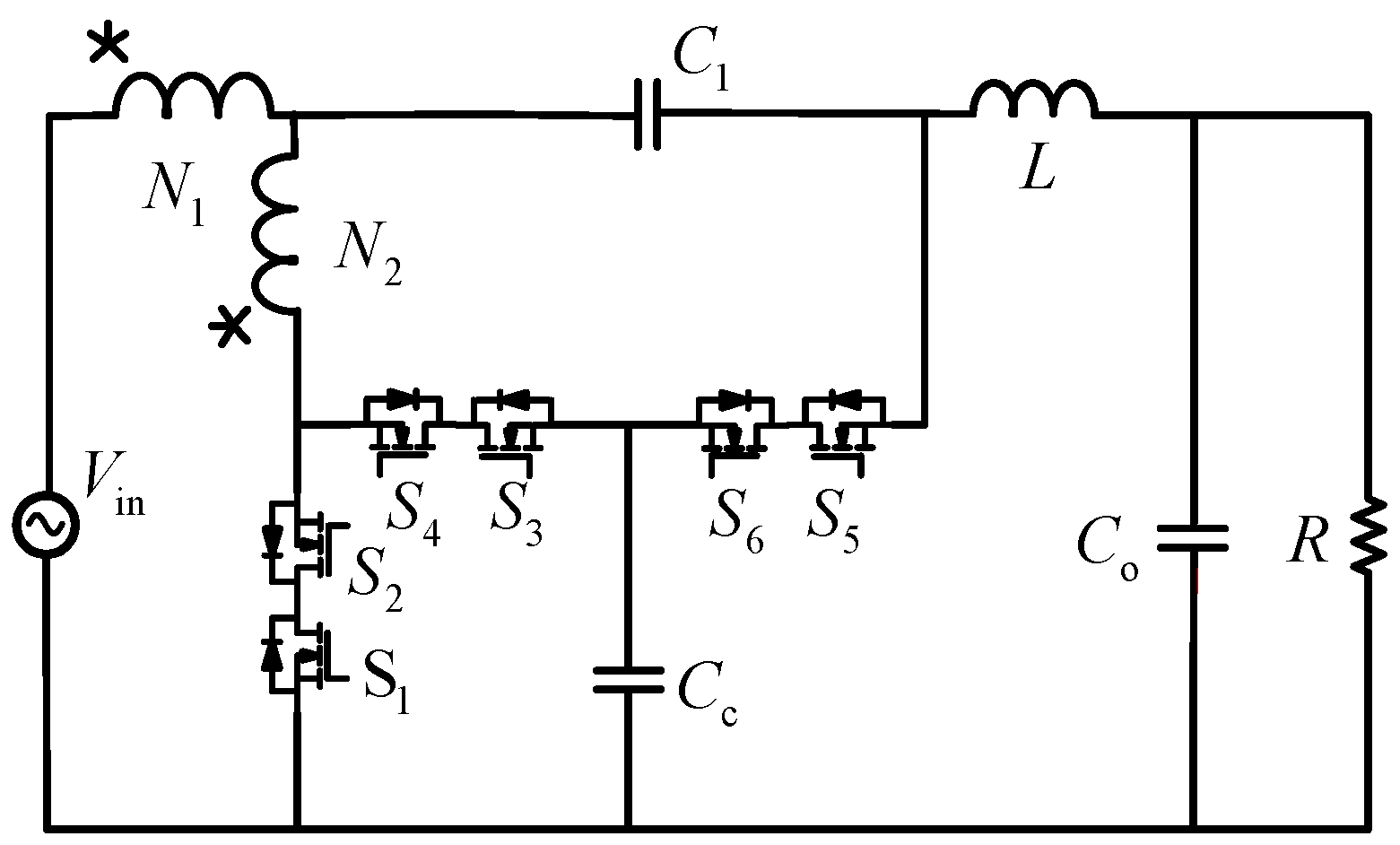


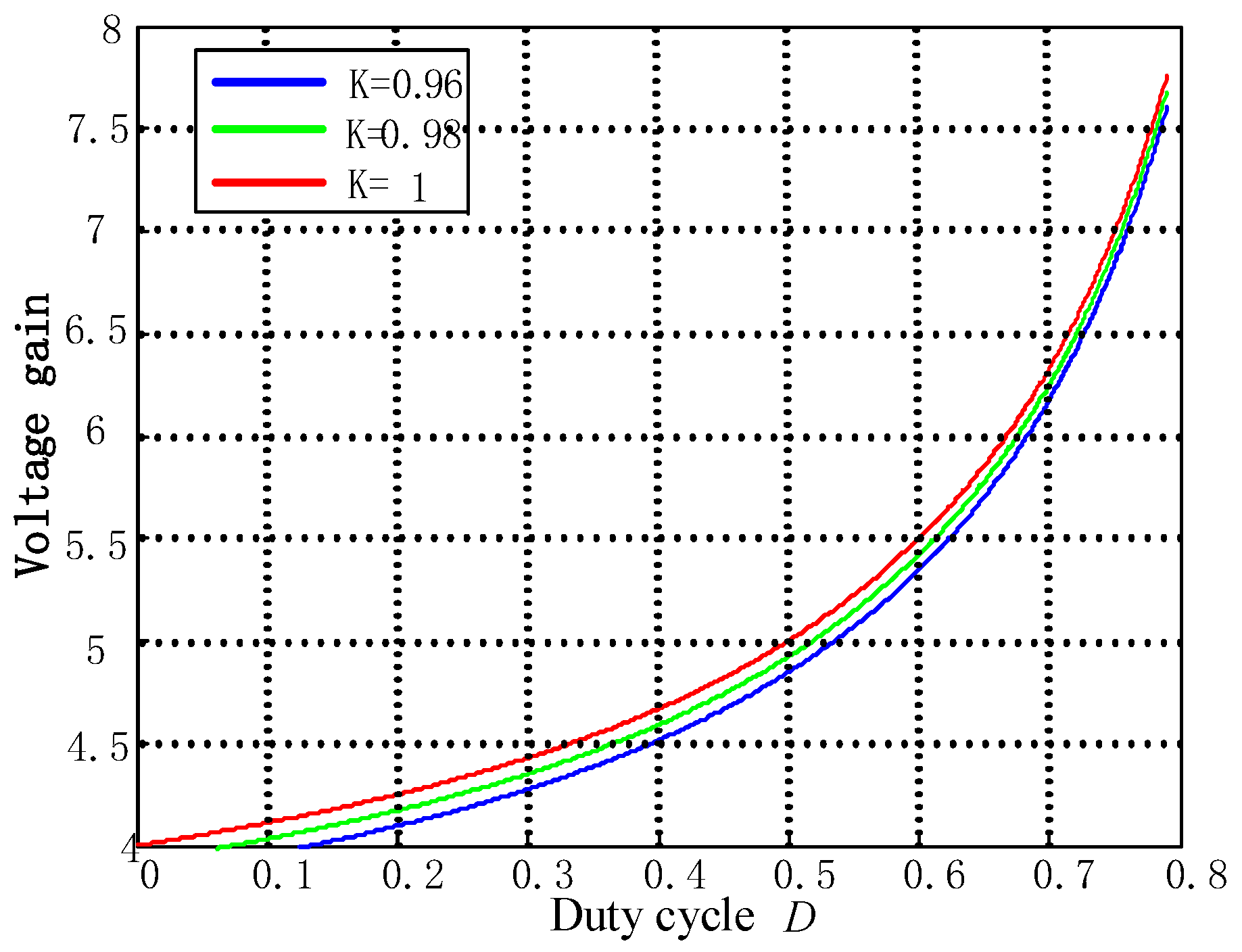



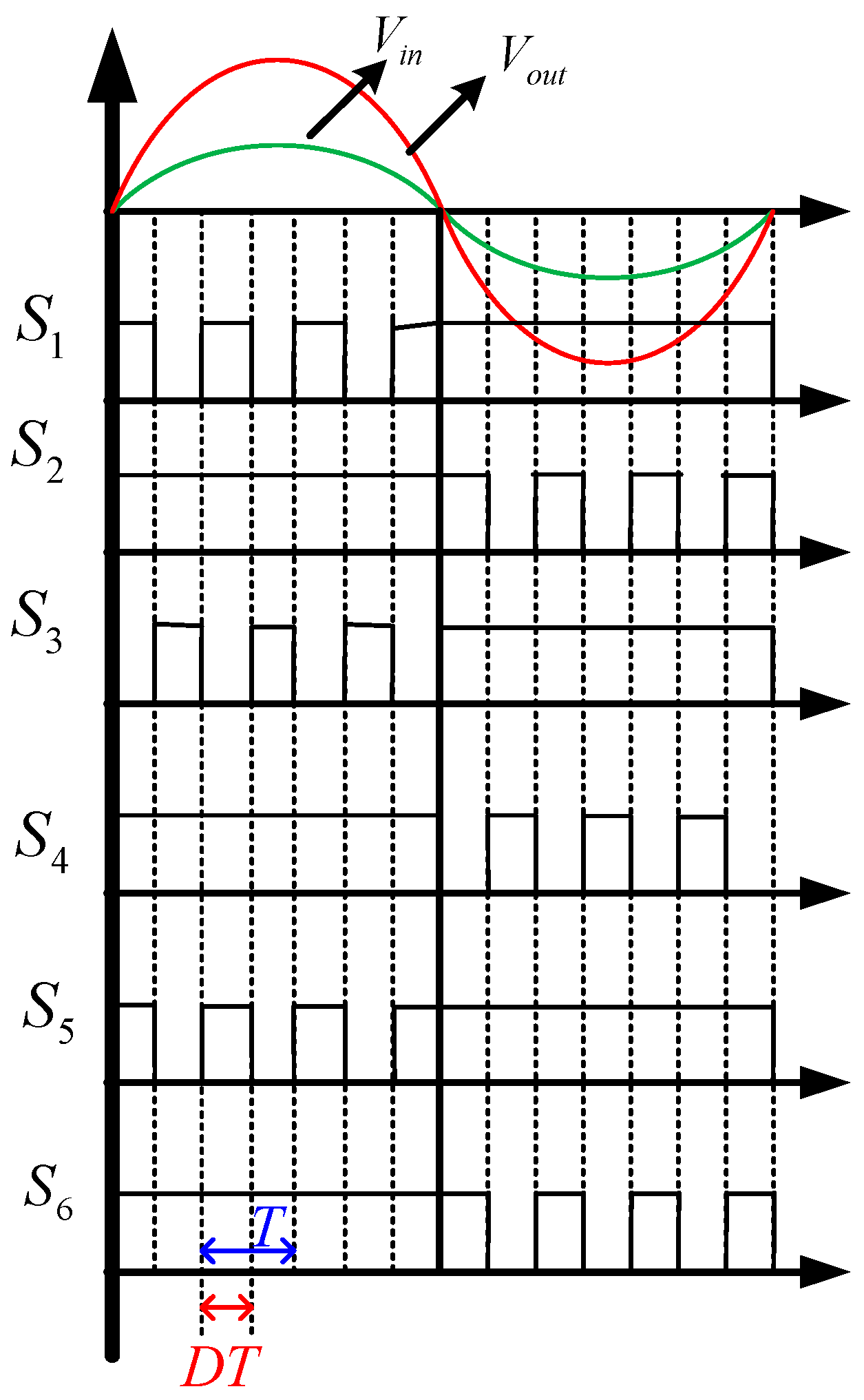
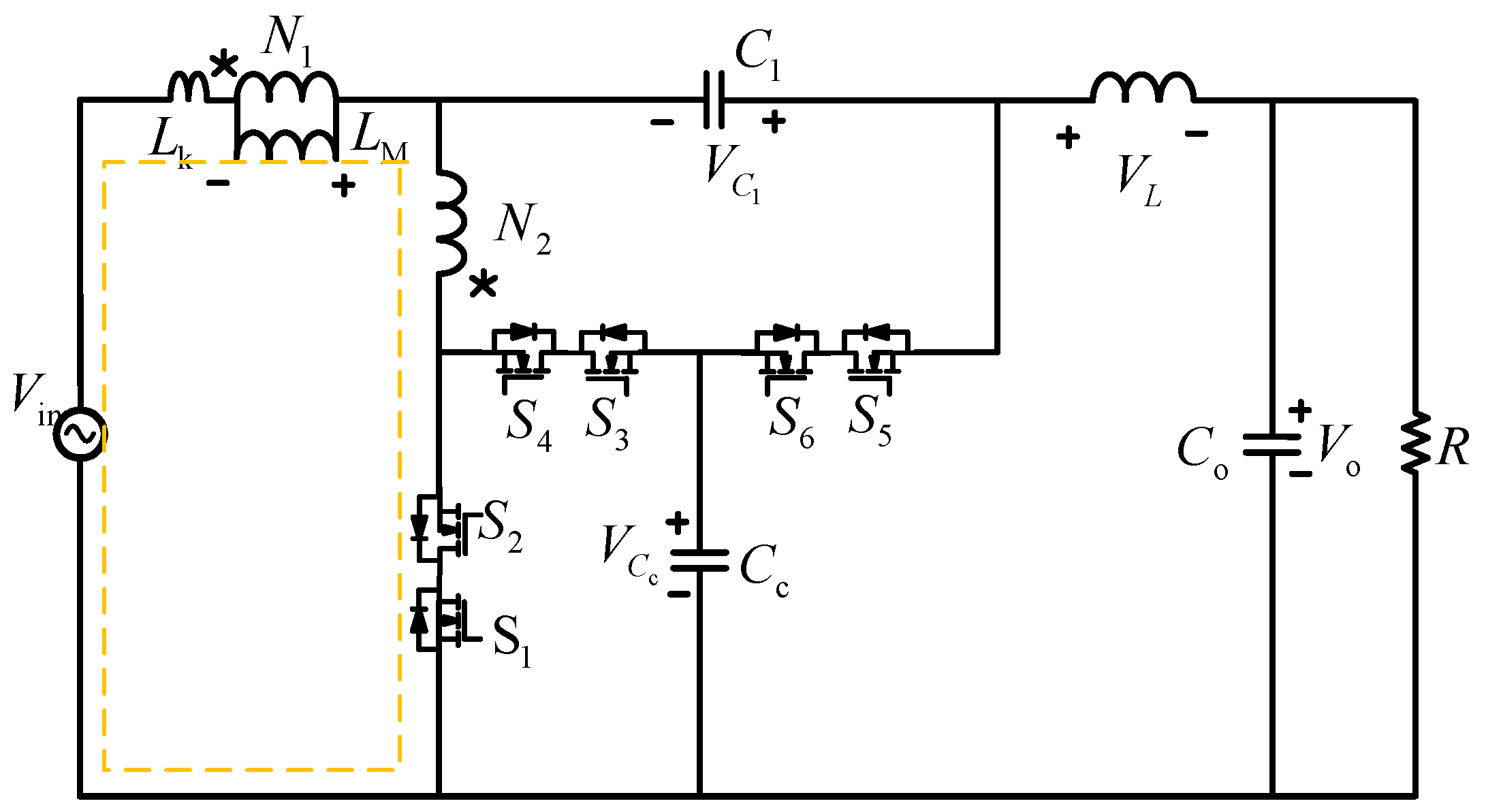
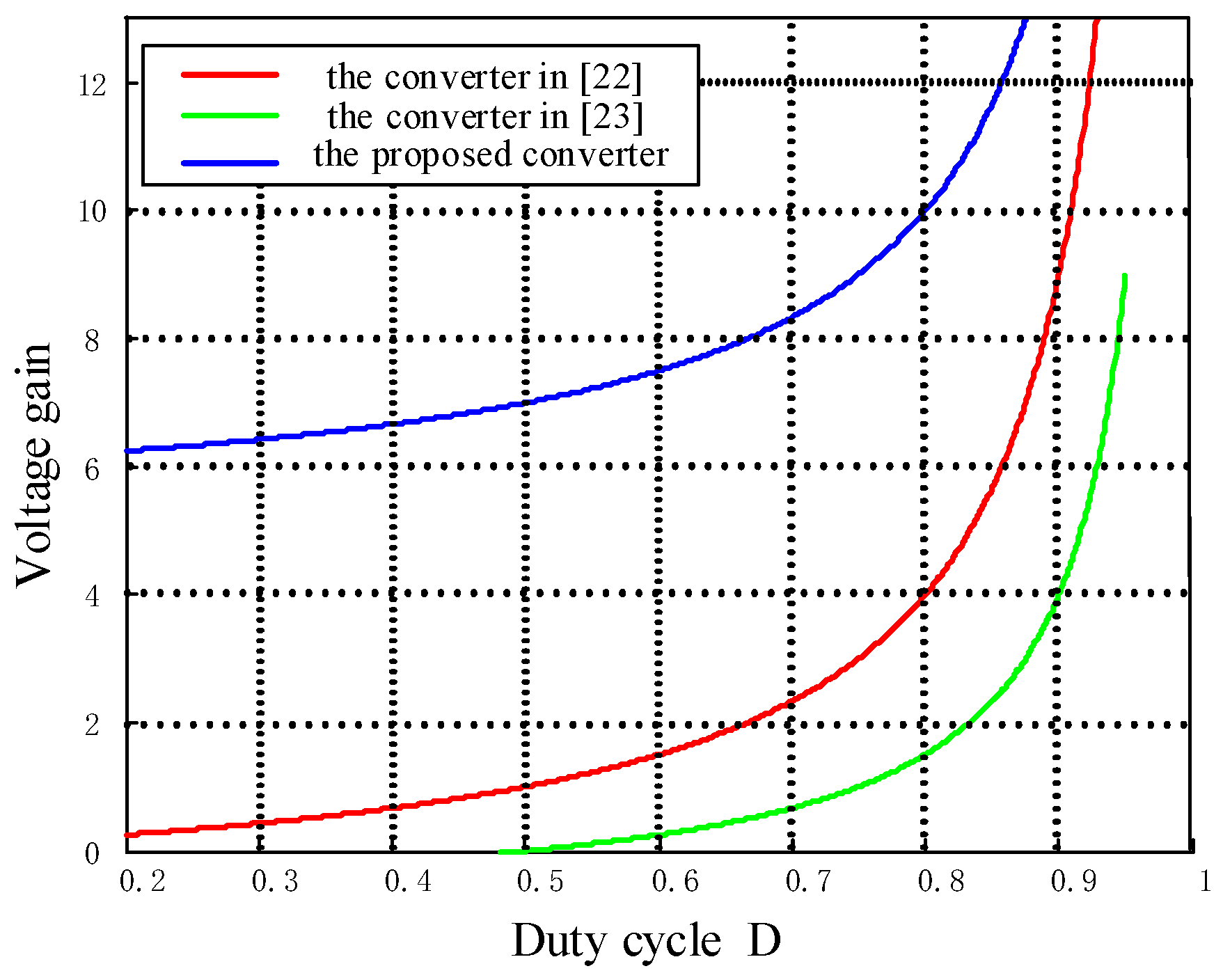
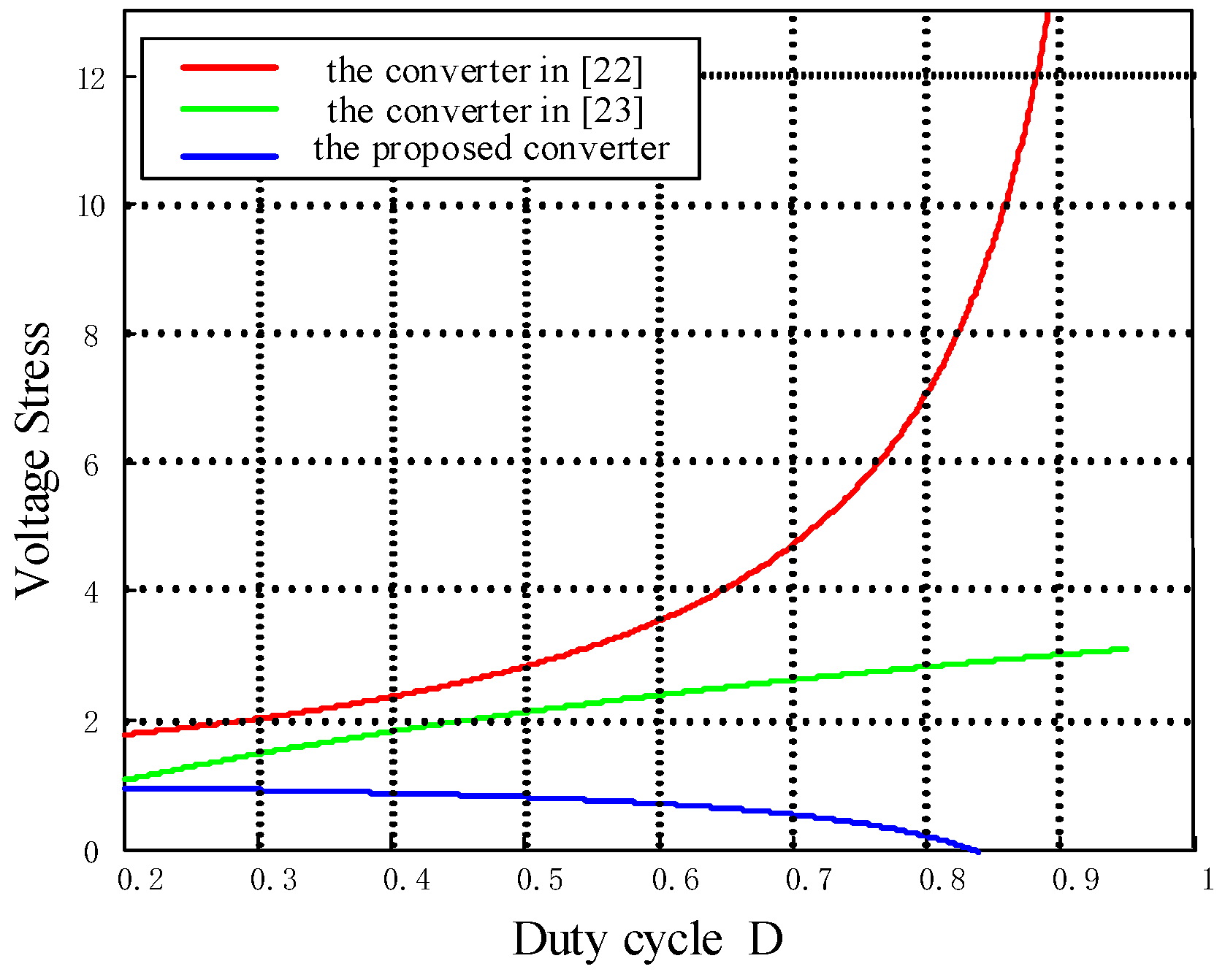
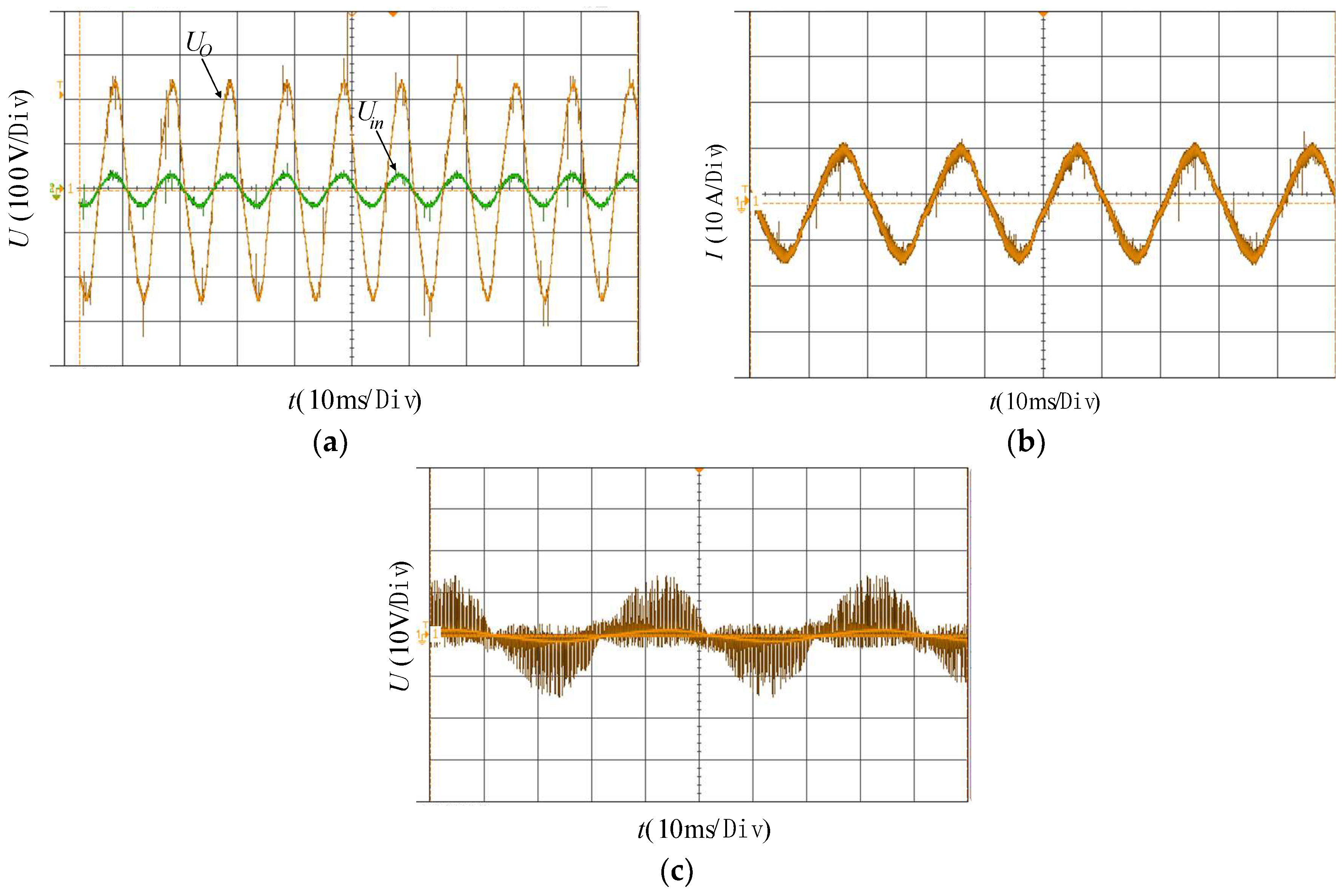
| Topology | Voltage Gain | Maximum Voltage Stress of Switches |
|---|---|---|
| Converter in [22] | ||
| Converter in [23] | ||
| The proposed converter |
| Components | Parameters | Components | Parameters |
|---|---|---|---|
| Maximum output power P | 250 W | Inductor L2 | 20 |
| Input voltage Vin | 30 V | Inductor L | 1 mH |
| Output voltage Vo | 250 V | C1 (Capacitor) | 4.7 |
| Switching frequency fs | 20 kHz | Cc (Capacitor) | 4.7 |
| Turns ratio n2/n1 of coupled inductor N | 1.5 | Co (Capacitor) | 20 |
| Inductor L1 | 45 | Power MOSFET Q | IRFP 250 N |
© 2018 by the authors. Licensee MDPI, Basel, Switzerland. This article is an open access article distributed under the terms and conditions of the Creative Commons Attribution (CC BY) license (http://creativecommons.org/licenses/by/4.0/).
Share and Cite
Liu, H.; Zhang, X. A Novel Reversal Γ-Shape Coupled Inductor High-Step AC-AC Converter. Energies 2018, 11, 2733. https://doi.org/10.3390/en11102733
Liu H, Zhang X. A Novel Reversal Γ-Shape Coupled Inductor High-Step AC-AC Converter. Energies. 2018; 11(10):2733. https://doi.org/10.3390/en11102733
Chicago/Turabian StyleLiu, Hongchen, and Xinsheng Zhang. 2018. "A Novel Reversal Γ-Shape Coupled Inductor High-Step AC-AC Converter" Energies 11, no. 10: 2733. https://doi.org/10.3390/en11102733
APA StyleLiu, H., & Zhang, X. (2018). A Novel Reversal Γ-Shape Coupled Inductor High-Step AC-AC Converter. Energies, 11(10), 2733. https://doi.org/10.3390/en11102733






